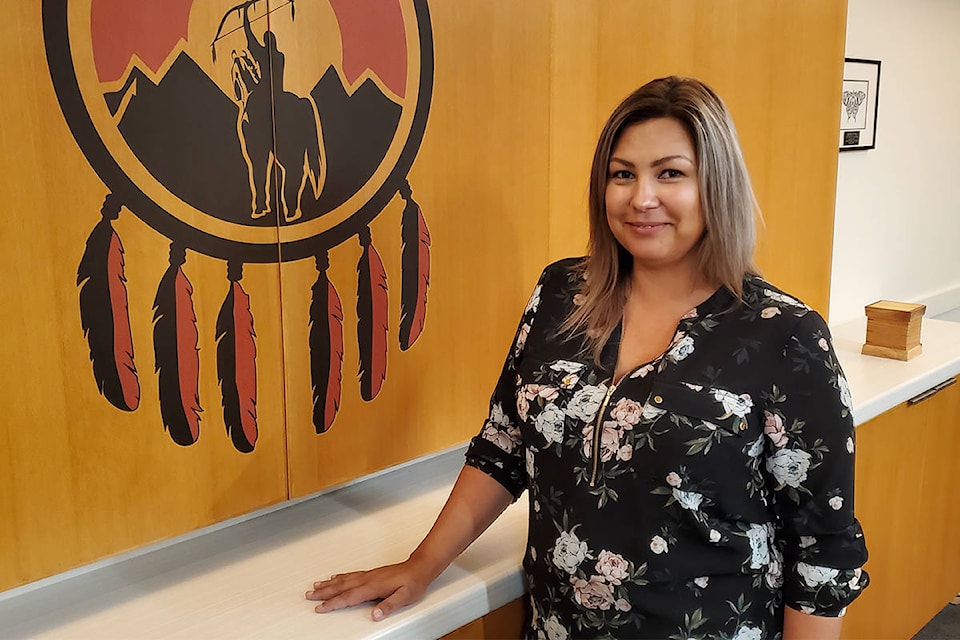The Tsilhqot’in National Government’s new executive director is enjoying the challenge and said as an Indigenous woman she feels it’s a great time to be part of history in the making.
Jenny Philbrick, 35, said her main tasks are to bring to light the goals and dreams of the six Tsilhqot’in communities through the chieftainships to help move forward the self-determination of the Tsilhqot’in people.
“Coming on already, there’s so much changing. I’ve come in after the title case, after the exoneration, and the signing of the tripartite agreement in August,” she said. “There’s just so much going on. I feel like it’s a really good time to be here.”
Praising the 60 staff members working for the TNG are productive and their hearts are in what they are doing, she added.
“We are all hoping for more economic development in the future.”
Read more: TNG, Federal, Provincial governments sign historic agreement
Philbrick feels supported by all the chiefs, managers and communities, she added.
“I know I don’t know it all and I have a lot to learn but there is a lot of pride that I am a Tsilhqot’in woman in this position.”
Her father Darryl Elkins is from Tl’etinqox (Anaham) First Nation and her mom Betty Price is from Williams Lake Indian Band so Philbrick said she has connections to both sides of the Fraser River.
She has four sisters, including Shawna Philbrick who is a councillor for the Williams Lake Indian Band, and a younger brother.
“I grew up in Williams Lake, Kelowna, Vancouver and Tl’etinqox (Anaham),” she told the Tribune. “I was living and working in Calgary and came back in March to be the HR manager and within two months I was acting executive director and it was going well so I decided to apply for the position.”
She first pursued a business degree in human resources at Mount Royal University in Calgary, and took many programs in leadership because it interested her.
While she finished university she worked in clothing retail and then for ATCO Structures and Logistics in Indigenous relations and human resources.
She also worked at Mount Royal University helping Indigenous students stay in school.
For a lot of the students it was their first time away from home and many were the first generation students in their families.
With the Calgary Chamber of Commerce she was part of the Indigenous opportunity committee, which she said was amazing.
Now she’s finishing up her master’s degree in Indigenous business and leadership through Simon Fraser University.
When asked if she always loved school, she chuckled and said she never did until she became a mom of two children — now 13 and 10 — and realized she wanted a better future for them.
“Now I can be a role model and preach to them and say, that I did it and they can do it.”
Being away from the region she watched the future of the Tsilhqot’in people unfold and said it has been great to return and help in whatever ways she can.
“I’m bringing back my Western knowledge and now I’m learning the Tsilhqot’in knowledge again and trying to combine it,” she said. “I know we cannot go back in history and make things the way they used to be, but to make things different and how it’s relative in this day and age to the Tsilhqot’in people.”
When her position was formally announced, many of the nation were at the Siwash gathering.
“It was quite special to be out on the land, knowing that our ancestors have been there for thousands of years,” she said. “My grandma, my dad and my kids were there. I had no clue it was going to happen, but Chief Joe Alphonse, Chief Otis Guichon and Chief Russell Myers Ross all introduced me.”
Working with the chiefs she’s learning about collaboration because they never leave a meeting until there is consensus, she said.
“They work together well and I think that’s why the tripartite agreement with the federal and provincial governments came about,” Philbrick said. “They are all working as a nation — you never hear ‘my community’ — it’s all about the Tsilhqot’in.”
Read more: TNG staff get emergency operations training
news@wltribune.com
Like us on Facebook and follow us on Twitter
